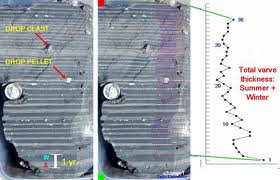Marvelous Varves
A post on
Facebook by WTCM’s Bill Froelich had a link to an article which contends that,
based on archeological earthquake studies, the date of the Crucifixion was
April 3, 33 A.D.
The article contains
this sentence: “Varves, which are annual layers of deposition in the sediments,
reveal that at least two major earthquakes affected the core: a widespread
earthquake in 31 B.C. and a seismic event that happened sometime between the
years 26 and 36.” The word varves caught
my eye.
The Oxford English
Dictionary expands on the
definition: “Varve: a pair of thin layers of clay and silt of contrasting
colour and texture which represent the deposit of a single year (summer and
winter) in still water at some time in the past (usually in a lake formed by a
retreating ice-sheet); they have been used to establish a chronology of the
late glacial and post-glacial period.”
Varve comes from the
Swedish word varv, a layer or
turn. While the OED’s first citation dates from 1887, it seems that the word received
professional endorsement and promulgation in the year 1912 in an article by G.
De Geer in Compt. Rend. XI Session Congrès Géol. Internat.
There he wrote, “The Swedish word varv, (old spelling: hvarf), means as
well a circle as a periodical iteration of layers. An international term for
the last sense being wanted, it seems suitable to use the transcription varve,
pl. -s, in English and French.”
Listen to Mike’s
program in real time every Tuesday morning, 9:00 - 10:00 a.m. EST, by going to
wtcmradio.com and clicking on Listen Now.
There is a collection of
podcasts. Go to wtcmradio.com and click on Podcasts. Scroll down The Ron Jolly Show to find the Words to the Wise audio
button.



Comments